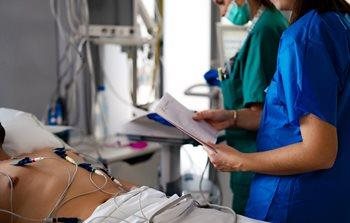
Myocardial Infarction: Recognition, Diagnosis, and Treatment
In the United States someone has a heart attack every 40 seconds, with about 805,000 people experiencing a heart attack ever year. Heart attacks, medically referred to as myocardial infarctions, can occur in any setting and at any time. This course is designed for medical professionals who care for patients in any type of setting, whether it is in the emergency department, an inpatient unit, an outpatient clinic, and for those who are wanting to expand their education regarding myocardial infarctions and the associated standards of care.
This course will focus on the pathophysiology and etiology of myocardial infarctions, as well as the symptomology. Readers will come to understand how to recognize signs and symptoms of a myocardial infarction, understand current diagnostic tools including ECGs and blood markers, guidelines for treatment, as well as pharmacological interventions to prevent further cell death. With heart disease being the leading cause of death in the United States, this course will cover myocardial infarction prevention methods and lifestyle modifications. Such interventions can help decrease the risks for experiencing a myocardial infarction and can be utilized to educate patients to decrease patient injury and death.
This course will focus on the pathophysiology and etiology of myocardial infarctions, as well as the symptomology. Readers will come to understand how to recognize signs and symptoms of a myocardial infarction, understand current diagnostic tools including ECGs and blood markers, guidelines for treatment, as well as pharmacological interventions to prevent further cell death. With heart disease being the leading cause of death in the United States, this course will cover myocardial infarction prevention methods and lifestyle modifications. Such interventions can help decrease the risks for experiencing a myocardial infarction and can be utilized to educate patients to decrease patient injury and death.
Objectives
Upon completion of this course, participants will be able to:
- Describe the difference between a myocardial infarction and unstable angina.
- Explain the major differences between a STEMI and a NSTEMI.
- List the causes of a myocardial infarction.
- Identify some of the risk factors pertaining to myocardial infarctions.
- List the signs and symptoms of a MI, including differences between men and women.
- Discuss the different diagnostic procedures for MIs.
- Describe the treatment options for a myocardial infarction.
- Identify the four stages of the CCS-AMI classification system.
- Explain nursing interventions when caring for a patient experiencing a myocardial infarction.
- List at least three MI prevention methods and lifestyle modifications.
Curriculum
Chapter 1: Pathophysiology
- Unstable Angina vs Myocardial Infarction
- Unstable Angina
- Myocardial Infarction
- Types of Myocardial Infarctions
- STEMI vs. NSTEMI
Chapter 2: Etiology/Causes
- Coronary Artery Disease
- Other Causes of Myocardial Infarctions
Chapter 3: Risk Factors
Chapter 4: Signs and Symptoms
- Signs and Symptoms of Myocardial Infarctions
- Symptoms and Gender
Chapter 5: Diagnosis
- Patient History
- Physical Assessment and Evaluation
- Pain Assessment
- Electrocardiogram Analysis
- ECG Basics
- Myocardial Infarction ECG Readings
- STEMI
- NSTEMI
- Cardiac Biomarkers
- Additional Testing
Chapter 6: Treatment
- Procedures and Surgeries
- Pharmacologic Interventions
- Long-Term Pharmacologic Management
Chapter 7: Classification of Acute Myocardial Infarction
-
CCS-AMI
Chapter 8: Nursing Interventions
Chapter 9: Prevention and Lifestyle Modifications
-
Myocardial Infarction Prevention Strategies
Chapter 10: References
Price: $18.00
Contact Hours: 1.5

Course Author
.jpg.aspx?width=70&height=80&resizemode=force)
Rachel Pugmire
Rachel Pugmire is a registered nurse and writer. She has experience in emergency medicine, home health, pediatrics and pharmaceutical clinical trials. She is passionate about sharing her knowledge and experience to benefit others.
Read Full Bio
Course Accreditation
See our Accreditation Statements page to view our accreditation information.